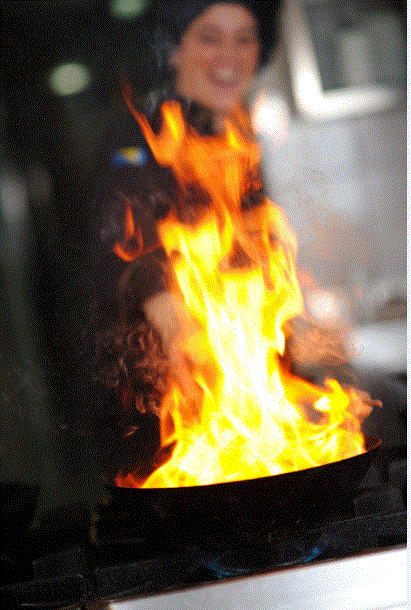Cooking with fire is an existential activity in which you must be completely present and responsive and engaged; you can’t be looking at some recipe or walking off to help with the potato salad.
- The more fire you are getting, the less smoke there is; the more smoke you are getting, the less fire there is. The key is controlling how much air gets in and out. Choke off the oxygen supply, and your fire will turn quickly to smoke—a cooler element that can nonetheless break down any meat in its grasp, while also having the side effect of flavoring it.
Do not, however, make the mistake of choking off air completely: Any live-fire cooking environment needs to breathe. If it gets sealed off, even the smoke will soon be extinguished—though not before depositing nasty, bitter-tasting black oils onto the food. - Not All Wood Burns the Same Way.
The Zen of wood-fire cooking comes from its intimacy and spontaneity, and the way it challenges you to constantly be aware of and adjust to what’s happening. Pieces of hickory that are all the same size may react differently during combustion. Oak burns at one heat, and white oak at another. Almond wood burns hot, and mesquite even hotter. Generally, I’d advise using whatever wood is easiest to get where you live. Terroir, not technique, gives regional grilling its identity. In the South, use hickory. In Texas, post oak or mesquite. In the Pacific Northwest, cherry. - Embrace Flare-Ups. As a seasoned and self-important grill man, I find that one of the pleasures of my life is a sour delight in the errors of other, better men. One such error is the terrified overreaction to the little grease explosions that, when fat starts to render into the fire, shoot upward in great orange plumes. These minor solar flares might seem to threaten to incinerate whatever is above them, but really, all they do is provide some drama and a little extra browning. If they get out of control, pull the meat off or close the grill lid.
Pieces less than an inch thick are hard to get really brown and crusty without overcooking them. So when their fat drips, and the fire flares, and a chain reaction of more dripping and more flaring occurs, you ought to thank the gods of barbecue rather than frantically pulling your ribs away. (Though you shouldn’t just ignore it, either. There is such a thing as a grease fire.) Because while you can burn even a thick piece of meat, that’s more often caused by leaving it on too long—which usually happens over slower fires, not faster ones. - You Can Grill in the Rain.
“You need a lot worse rain than this to put out a good fire. A match will go out when a drop of water hits it, but ten pounds of concentrated charcoal is not a match. Unless you are talking about a torrential downpour, the fire will burn off a light rain as easily as it browns a knockwurst. You might want to have some kind of tent or tree branch covering it, but even without protection your heat is likely to be pretty steady, even in a light rain or snow (for the laudable winter grillers out there). The down side is that when you want to put your fire out, it will take much, much more than a few cups of water to do so.


